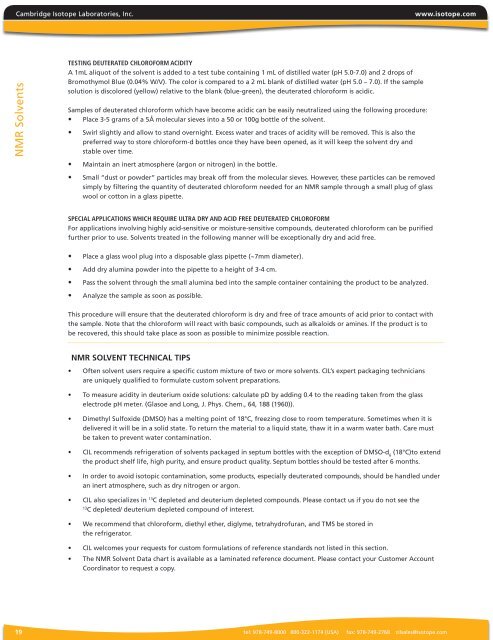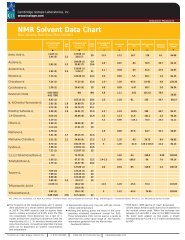Deuterated Solvents for NMR - Cambridge Isotope Laboratories
Deuterated Solvents for NMR - Cambridge Isotope Laboratories
Deuterated Solvents for NMR - Cambridge Isotope Laboratories
You also want an ePaper? Increase the reach of your titles
YUMPU automatically turns print PDFs into web optimized ePapers that Google loves.
<strong>Cambridge</strong> <strong>Isotope</strong> <strong>Laboratories</strong>, Inc. www.isotope.com<br />
<strong>NMR</strong> <strong>Solvents</strong><br />
19<br />
teStIng deuterated ChLoroForm aCIdIty<br />
A 1mL aliquot of the solvent is added to a test tube containing 1 mL of distilled water (pH 5.0-7.0) and 2 drops of<br />
Bromothymol Blue (0.04% W/V). The color is compared to a 2 mL blank of distilled water (pH 5.0 – 7.0). If the sample<br />
solution is discolored (yellow) relative to the blank (blue-green), the deuterated chloro<strong>for</strong>m is acidic.<br />
Samples of deuterated chloro<strong>for</strong>m which have become acidic can be easily neutralized using the following procedure:<br />
• Place 3-5 grams of a 5Å molecular sieves into a 50 or 100g bottle of the solvent.<br />
• Swirl slightly and allow to stand overnight. Excess water and traces of acidity will be removed. This is also the<br />
preferred way to store chloro<strong>for</strong>m-d bottles once they have been opened, as it will keep the solvent dry and<br />
stable over time.<br />
• Maintain an inert atmosphere (argon or nitrogen) in the bottle.<br />
• Small “dust or powder” particles may break off from the molecular sieves. However, these particles can be removed<br />
simply by filtering the quantity of deuterated chloro<strong>for</strong>m needed <strong>for</strong> an <strong>NMR</strong> sample through a small plug of glass<br />
wool or cotton in a glass pipette.<br />
SPeCIaL aPPLICatIonS WhICh reQuIre uLtra dry and aCId Free deuterated ChLoroForm<br />
For applications involving highly acid-sensitive or moisture-sensitive compounds, deuterated chloro<strong>for</strong>m can be purified<br />
further prior to use. <strong>Solvents</strong> treated in the following manner will be exceptionally dry and acid free.<br />
• Place a glass wool plug into a disposable glass pipette (~7mm diameter).<br />
• Add dry alumina powder into the pipette to a height of 3-4 cm.<br />
• Pass the solvent through the small alumina bed into the sample container containing the product to be analyzed.<br />
• Analyze the sample as soon as possible.<br />
This procedure will ensure that the deuterated chloro<strong>for</strong>m is dry and free of trace amounts of acid prior to contact with<br />
the sample. Note that the chloro<strong>for</strong>m will react with basic compounds, such as alkaloids or amines. If the product is to<br />
be recovered, this should take place as soon as possible to minimize possible reaction.<br />
<strong>NMR</strong> SOLVENT TEChNICAL TIPS<br />
• often solvent users require a specific custom mixture of two or more solvents. CIL’s expert packaging technicians<br />
are uniquely qualified to <strong>for</strong>mulate custom solvent preparations.<br />
• To measure acidity in deuterium oxide solutions: calculate pD by adding 0.4 to the reading taken from the glass<br />
electrode pH meter. (Glasoe and Long, J. Phys. Chem., 64, 188 (1960)).<br />
• Dimethyl Sulfoxide (DMSo) has a melting point of 18°C, freezing close to room temperature. Sometimes when it is<br />
delivered it will be in a solid state. To return the material to a liquid state, thaw it in a warm water bath. Care must<br />
be taken to prevent water contamination.<br />
• CIL recommends refrigeration of solvents packaged in septum bottles with the exception of DMSo-d 6 (18°C)to extend<br />
the product shelf life, high purity, and ensure product quality. Septum bottles should be tested after 6 months.<br />
• In order to avoid isotopic contamination, some products, especially deuterated compounds, should be handled under<br />
an inert atmosphere, such as dry nitrogen or argon.<br />
• CIL also specializes in 13 C depleted and deuterium depleted compounds. Please contact us if you do not see the<br />
13 C depleted/ deuterium depleted compound of interest.<br />
• We recommend that chloro<strong>for</strong>m, diethyl ether, diglyme, tetrahydrofuran, and TMS be stored in<br />
the refrigerator.<br />
• CIL welcomes your requests <strong>for</strong> custom <strong>for</strong>mulations of reference standards not listed in this section.<br />
• The <strong>NMR</strong> Solvent Data chart is available as a laminated reference document. Please contact your Customer Account<br />
Coordinator to request a copy.<br />
unit<br />
tel: 978-749-8000 800-322-1174 (USA) fax: 978-749-2768 cilsales@isotope.com







